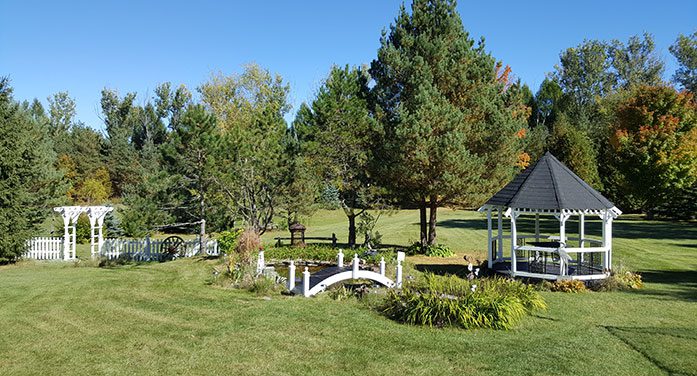
 I recently wrote about haying and the delicate balance between harvesting a crop and protecting nesting birds. Today, I would like to offer some advice to help us protect the beauty and functionality of our properties while simultaneously protecting wildlife.
I recently wrote about haying and the delicate balance between harvesting a crop and protecting nesting birds. Today, I would like to offer some advice to help us protect the beauty and functionality of our properties while simultaneously protecting wildlife.
Why should we care?
Wildlife is more than just an attractive feature of the landscape; it represents a complex web of life where each piece is dependent on the other. Flowers bloom so bugs can eat and, in so doing, pollinate the plants. The plants then provide food for insects and herbivores, which then are food for other animals. Without plants and insects, we wouldn’t have food for ourselves, nor would most wild things exist.
Whatever we can do to help insects survive is exponentially more valuable than practically anything else we do to help nature.
Small urban yards
What difference can a tiny patch make?
Careful planting of native species can significantly enhance the natural value of your plot. Additionally, allowing some wildness along the edges of your garden adds even more value.
 |
| Related Stories |
| Fall is in the air and trees are changing colour
|
| Canada Jay is the best choice to be our national bird
|
| There’s room for everyone in nature – if we’re respectful
|
At the end of the season, place fallen leaves on the soil between your plants and bushes to provide overwintering insects somewhere to hide. As the leaves decompose, they also add nutrients to your soil and prevent weeds from growing.
Likewise, leave the seed heads on flowers for winter birds and don’t cut down the stalks so overwintering insects can have somewhere to hide.
Larger yards
If your yard is bigger – half an acre or larger – consider leaving part of it to nature. Create a meadow and let nature choose the plants. That way, the balance is created for you, and the insects and animals that occupy natural habitats will come.
A manicured expanse of lawn may look pretty but it adds little value to the natural landscape.
In my rural neighbourhood, several households have chosen to only mow part of their plots, leaving the rest to nature. Clusters of trees, pollinator gardens and artificial (but managed) ponds add significant value for wildlife.
Industrial, commercial plots
If you’re an industrial or commercial landowner, the same principles apply. Do you really have to mow every inch of your lands?
The public would appreciate a safe and attractive entrance to the buildings and a more nature-friendly landscape on the rest of the plot.
Municipalities
Municipalities (both upper and low tier) are responsible for roadside mowing, an especially challenging balance for them as they have to consider nature, but more importantly, safety and the integrity of the infrastructure. I understand the challenge, but I often think municipalities mow areas too wide and at the wrong time of year.
I travel widely at this time of year conducting breeding bird surveys and frequently have to use major highways in Ontario. I’m shocked at the massive areas they often clear during the height of the breeding and fall pollinator seasons. A swath on both shoulders and in the median can measure over 100-plus metres in width for tens of kilometres.
Why is it necessary to do this? No cars need to access the median, so why mow it? The shoulders need to be maintained but do the mowers have to go 10 or 15 or more metres off the shoulder and buffers?
One unfortunate side effect of this mowing is that tonnes of litter (e.g. plastics) are shredded by the mowers, and we all know how bad that is. In our area, municipalities still cut too much vegetation.
I would encourage everyone to reconsider when and how much they cut. One simple thing to consider is to minimize the footprint of the mowed area in spring and summer when birds are nesting. In the fall, when pollinators are very active, don’t cut the roadsides unless necessary for safety and, again, minimize the footprint.
Doing these simple things can make our environment better and healthier. Please do what you can to help nature.
Geoff Carpentier is a published author, expedition guide and environmental consultant. Visit Geoff on LinkedIn, Instagram and Facebook.
For interview requests, click here.
The opinions expressed by our columnists and contributors are theirs alone and do not inherently or expressly reflect the views of our publication.
© Troy Media
Troy Media is an editorial content provider to media outlets and its own hosted community news outlets across Canada.


